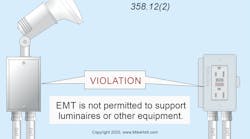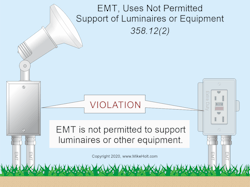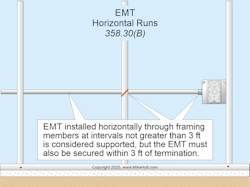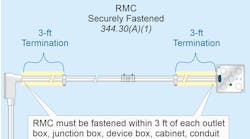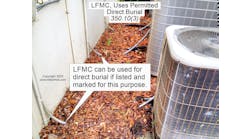Q: What is the minimum and maximum EMT trade size permitted?
A: The minimum and maximum EMT trade size permitted is stated in Sec. 358.20.
(A) Minimum. EMT smaller than trade size ½ is not permitted.
(B) Maximum. EMT larger than trade size 4 is not permitted.
Q: What are the requirements for securing and supporting EMT?
A: Section 358.30 gives the requirements for securing and supporting EMT.
EMT must be securely fastened in place and supported in accordance with (A) and (B).
(A) Securely Fastened. EMT must be securely fastened within 3 ft of every box, cabinet, or termination fitting, and at intervals not exceeding 10 ft.
Author’s Comment: Fastening is required within 3 ft of termination, not within 3 ft of a coupling.
Exception No. 1: When structural members do not permit the raceway to be secured within 3 ft of a box or termination fitting, an unbroken raceway can be secured within 5 ft of a box or termination fitting.
(B) Horizontal Runs. EMT installed horizontally in bored or punched holes in wood or metal framing members, or notches in wooden members at intervals not greater than 3 ft, is considered supported, but the raceway must be secured within 3 ft of termination (Fig. 2).
